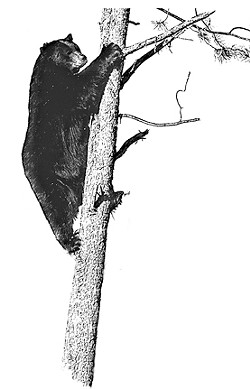[{
"name": "Ad - Medium Rectangle CC01 - 300x250",
"id": "AdMediumRectangleCC01300x250",
"class": "inlineCenter",
"insertPoint": "8",
"component": "2963441",
"requiredCountToDisplay": "12"
},{
"name": "Ad - Medium Rectangle LC01 - 300x250",
"id": "AdMediumRectangleCC01300x250",
"class": "inlineCenter",
"insertPoint": "18",
"component": "2963441",
"requiredCountToDisplay": "22"
},{
"name": "Ad - Medium Rectangle LC09 - 300x250",
"id": "AdMediumRectangleLC09300x250",
"class": "inlineCenter",
"insertPoint": "28",
"component": "3252660",
"requiredCountToDisplay": "32"
}]
The black bear—Ursus americanus—is an enduring symbol of wild forests across America. Once threatened by unrestricted hunting and development, black bears have staged a remarkable comeback and are reestablishing themselves in areas where they’ve not been seen in decades, including right here in San Luis Obispo County.
But plans to expand bear hunting locally and statewide threaten to reverse a century of progress in restoring our forest ecosystems. Last month, the California Department of Fish and Game announced a plan to allow trophy hunting of black bears in San Luis Obispo County. The department is also proposing to lift all numerical limits to the number of bears that can be hunted and killed throughout the state.
The most troubling aspect of this plan is that the department has no idea how many bears exist in San Luis Obispo County. Biologists have never conducted a bear census here, and lack the data to estimate, or even guess, how many black bears roam our county’s hills, canyons, and wilderness areas. The department estimates that as many as 50 bears could be hunted and killed in the county each year, but nobody knows what percentage of the population this represents.
Instead, biologists only know roughly where bears are located in the county, not how many actually reside here. The department conducted a “bait study,” hanging cans of fish from tree limbs in various locations throughout the county and returning each day to observe puncture marks or bear tracks. While bait studies are good indicators of relative bear density (i.e., where bears occur), they do not provide actual numbers.
Accurate population studies would give biologists a much better idea of how many bears exist in our area. For example, DNA analysis of hair or scat can distinguish one bear from another, providing precisely the data needed for a reliable population estimate. Oklahoma recently completed a DNA study of its bears. And if Oklahoma can do it, certainly California can, too.
But in a rush to satisfy trophy hunters and their Sacramento lobbyists, the department appears poised to violate not only the California Environmental Quality Act, but also every single principle of wildlife conservation that has developed over the last century. This is a shocking stance for an agency that is charged with managing our state’s wildlife.
Field & Stream magazine recently reported that poaching is on the rise in California: a clear sign that the department lacks a sufficient number of wardens to patrol existing levels of hunting. In fact, California ranks dead last in the country for its per-capita ratio of wardens to population. It’s simply inappropriate to consider expanding hunting, when the department cannot adequately enforce existing levels.
In addition to these practical concerns, there are also ethical concerns about how most bears are hunted—with packs of hounds that will chase a bear to the point of exhaustion, forcing it to climb a tree where it’s then cornered and shot. Calling this practice unsportsmanlike, many states have banned hound hunting, but California is one of the few states where it’s still allowed.
Bears are being seen in increasing numbers in our county’s wild places, and there have been several reports of cars striking bears on the Cuesta Grade. These are not indicators that our county’s bear populations are excessive. Instead, they tell us that bears are simply doing what bears do best: roaming across large expanses of open space, minding their own business, forging strong bonds with their young, and filling an important ecological niche.
We pride ourselves on the vast expanses of open space surrounding our communities. These are the very same areas that provide prime habitat for black bears and thousands of other plants and animals that make this a healthy ecosystem. A robust black bear population gives us comfort that our local wild places are alive and well.
Submit your comments
Tell the department that you want accurate population studies of our county’s bears before a hunt is authorized. Urge the agency to increase the number of wardens across the state to prevent poaching before they even consider expanding hunting. And request a public hearing on this issue in San Luis Obispo County, not in a town more than two hundred miles away, where the hearing is currently scheduled to take place.
To voice your concerns over trophy bear hunting in San Luis Obispo County, write to the California Fish and Game Commission at [email protected] or 1416 Ninth Street, Room 1320, Sacramento, CA 95814. Comments must be received by April 18, but will be most effective if they are received by April 10.
With your help, we can continue to give bears the freedom to roam in San Luis Obispo County.
Jeff Kuyper is Executive Director of Los Padres ForestWatch, a nonprofit organization working to protect wildlife and wilderness in the Los Padres National Forest. Visit their website at LPFW.org.
Latest in Commentaries
Readers also liked…
-
A happy ending
Sep 22, 2022 -
SLO County's response to Los Osos mudslide highlights a lack of representation
Feb 16, 2023





April 08, 2009 Opinion » Commentaries